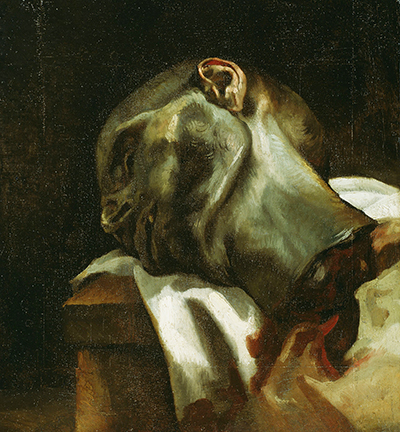Theodore Gericault loved to paint horses and beautifully muscled young men, but he was also very aware of the more horrific side of life.
Insanity ran in his family and he did not shy away from realisation of his own mortality, indulging this fascination in a series of paintings and sketches that can only be described as grisly. One such painting is this: Head of a Guillotined Man, painted in oils on a wooden panel. In the image, there is no doubt that the man is dead. While the position of his head against the sheet in which, presumably, the gruesome artefact is about to be wrapped, can make it seem on first, very superficial glance, to be a relaxed positions, something like a sleeper's pose, the fact of his decease is made clear by two things: the grey cyanosed skin and the explicit depiction of the decapitation.
The thick vein and strong tendons in the man's neck are clearly discernible but they lead nowhere, being abruptly truncated by the bloody wound where his body should be. Seeing these two aspects makes it clear that the looseness of the man's mouth – what might be an amusing indication of a snorer in a live subject – is caused because there is no longer any muscle engagement to keep the mouth firmly aligned and closed. This makes the head even more of an object of pity than it would otherwise be, bringing home the dark reality of what the viewer is seeing.
The truth behind this painting and other similar studies that Gericault undertook are simultaneously piteous and understandable. In June 1816, a ship named the Medusa set sail for Senegal but got into trouble and ran aground in early July. Abandoned by their captain who left with other survivors on the inadequate lifeboats, the survivors decided to construct a raft from materials to be found on the stuck and slowly foundering ship. Around 150 passengers set off on the raft, drifting aimlessly for days. When the raft finally came into land twelve days later, there were only fifteen survivors left, and they had suffered thirst, starvation and been forced into cannibalism of the dead.
Horrified, like much of the population, by this tale, Gericault began to work towards creating a memorial to this event. He succeeded and the Raft of the Medusa is now perhaps his best known work – and it is thanks in no small part to studies such as this one. Gericault took the body parts to his studio and observed their deterioration over time, watching as the skin discoloured and oozed, and accurately sketching each change in the body parts. This grim but curiously sympathetic painting, measuring 41 centimetres by 38 centimetres, can be found in the Art Institute of Chicago.




